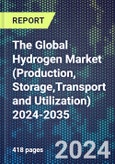Demand for hydrogen and its derivatives is increasing, buoyed by sustainability initiatives and government funding. This extensive report examines the emerging global hydrogen market, providing 11-year projections across production, infrastructure, storage, distribution and end-use applications.
It assesses mainstream hydrogen varieties produced from renewable electricity, fossil fuels, and biomass etc. Competitive analysis compares commercial readiness, scalability potential and environmental impact to guide research and adoption roadmaps. Profiles of over 200 companies span electrolyzer manufacturing, hydrogen-based fuel synthesis, CO2 utilization, distribution logistics, dispensing infrastructure, storage vessels and fuel cell development etc.
Regional analysis covers North America, Europe, Asia Pacific and Rest of World markets based on national strategies, resource advantages and de-carbonization commitments driving public and private investments. Falling electrolysis costs, increasing scale manufacturing, maturing synthetic fuel pathways and intensifying policy tailwinds provide strong signals for an expanding role of hydrogen supporting decarbonization of industrial sectors and long-haul transport while providing vital grid balancing via energy storage. However, major challenges exist around achieving fossil independence, infrastructure availability, international standards development and coordinated adoption linkages between producing vs demanding sectors.
The report enables navigation of this complex ecosystem for practitioners through detailed assessments spanning science, industry activity and geopolitics needed for hydrogen to deliver on its immense promise supporting urgent real-economy de-carbonization.
Report contents include:
- Assessment of hydrogen production methods - electrolysis, natural gas reforming, coal gasification etc.
- Analysis of hydrogen varieties - green, blue, pink, turquoise etc.
- Profiles of 200 companies across the hydrogen value chain. Companies profiled include Advanced Ionics, Aker Horizons, C-Zero, Constellation, Dynelectro, Ekona Power, Electric Hydrogen, Enapter, EvoIOH, FuelCell Energy, Heliogen, HiiROC, Hycamite, Hystar, HydrogenPro, Innova Hydrogen, Ionomr Innovations, ITM Power, Jolt Electrodes, McPhy Energy SAS, Monolith Materials, NEL Hydrogen, Ohmium, Parallel Carbon, Plug Power, PowerCell Sweden, Pure Hydrogen Corporation Limited, Sunfire, Syzgy Plasmonics, Thiozen, Thyssenkrupp Nucera and Verdagy.
- Cost evolution analysis, scalability assessments and forecasts
- Technology analysis for hydrogen liquefaction, storage and transportation
- Applications and adoption roadmaps across transport, chemicals, steelmaking etc.
- Hydrogen utilization in fuel cells, internal combustion engines, turbines
- Synthetic fuels manufactured using hydrogen as key feedstocks
- National hydrogen strategies and policy frameworks globally
- Production trends and forecasts across Americas, Europe, Asia Pacific
- Renewable hydrogen for grid balancing and buffering intermittent supply
- Industrial usage for high-grade process heating requirements
- Decarbonization enabler for heavy industries like steel, shipping, aviation
- Market challenges around infrastructure availability, production costs, distribution networks
Table of Contents
1 RESEARCH METHODOLOGY
Companies Mentioned (Partial List)
A selection of companies mentioned in this report includes, but is not limited to:
- Advanced Ionics
- Aker Horizons
- C-Zero
- Constellation
- Dynelectro
- Ekona Power
- Electric Hydrogen
- Enapter
- EvoIOH
- FuelCell Energy
- Heliogen
- HiiROC
- Hycamite
- Hystar
- HydrogenPro
- Innova Hydrogen
- Ionomr Innovations
- ITM Power
- Jolt Electrodes
- McPhy Energy SAS
- Monolith Materials
- NEL Hydrogen
- Ohmium
- Parallel Carbon
- Plug Power
- PowerCell Sweden
- Pure Hydrogen Corporation Limited
- Sunfire
- Syzgy Plasmonics
- Thiozen
- Thyssenkrupp Nucera
- Verdagy
Methodology

LOADING...








